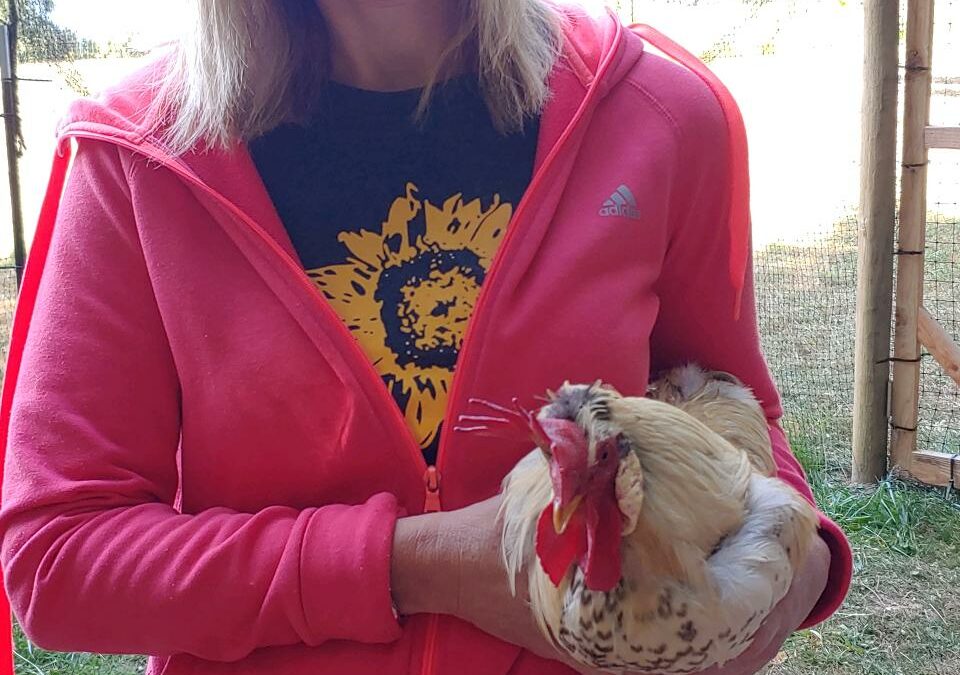It has been a while since I last wrote about my chicken adventures. In late June, our flock grew to 20. Our three broody hens hatched 14 peeps. At some point, I’ll share that whole rather stressful adventure, but for now, I’ll skip over becoming a chicken grandma and instead turn my attention (and your attention) back to my mean rooster, Oden. If you recall, a few months ago I wrote an article titled “Right Seat, Wrong Chicken.” Oden’s behavior continued to escalate after recovering from the Great Chicken Massacre. It got to the point that I was working my chicken duties around his schedule, i.e., only entering the run when he was in the coop, which resulted in late nights and early mornings.
A few weeks ago, my chicken coach came to visit. She marched right into the run and headed toward Oden. He sensed her lack of fear and retreated. Then she caught him and put him upside-down. And once a chicken is upside-down, the balance of power shifts—at least for the person who put him upside down. I held Oden for a while, and we eventually let him resume his daily activities. But I soon learned that until I caught him, he would still be aggressive with me. So, the following week—I did it! I caught Oden myself and held him upside down. Now I am at the top of the pecking order, and Oden has become a “Right Chicken, Right Seat” member of my flock.
I can think of two ways to pivot this story toward business: overcoming our fears or becoming a better leader. Given the current shortage of employees, I’m going to pivot toward leadership.
Most employers are struggling to find people to fill their open positions, especially people who show up on time and want to do the work. This shortage results in either settling for less-than-ideal candidates or slowing growth until more employees can be hired.
It might help to think about the reasons for the employee shortage. After surviving the pandemic, many people have changed their priorities, and this shift has impacted the way they view their work. They may be less willing to take a job just to earn a paycheck. Based on my research, there isn’t a shortage of employees, but rather a shortage of enticing opportunities. I’d like to offer up three questions that may help you reframe your approach to attracting and retaining your ideal employee.
1. Is there consistency between what you say you want and what you accept? As we say in EOS, you get what you tolerate. In a time when finding qualified employees is very difficult, it may be tempting to tolerate employee behavior that is contrary to your core values. But that behavior is eroding your culture and lowering the standard for everyone. Addressing that employee with clear examples of the type of behavior that you won’t tolerate is the best way to tackle the problem. If he or she can’t adjust their behavior, you will need to make the hard decision to let them go. It has been my experience that such decisions are rewarded as other employees step up to fill the void.
2. Are you clear about your vision and your core values? Are you using those to inform your hiring decisions? A person with passion for your vision who demonstrates your core values on a daily basis will outperform any other employee. If you share your vision and core values during the recruiting and hiring process, the odds of attracting an ideal candidate will increase. Yes, it will narrow down the number of candidates, but the quality of the candidates will be much higher.
3. Are you managing your employees in such a way that they can’t imagine not working for you? This can be an uncomfortable question to answer. But if you can answer it in the affirmative, you will have an advantage over other companies competing for the same pool of candidates. What would it take to have employees who are fiercely loyal to you and your company? (Hint, it isn’t a higher salary.)
If after answering those questions you find that there are opportunities for improvement, I’d like to introduce you to EOS (Entrepreneurial Operating System), an operating system that helps owners and their leadership teams get what they want from their businesses. When implementing EOS, I teach how to utilize a simple set of tools that help you clarify your vision, gain traction on that vision by instilling discipline and accountability throughout the organization, and then transform your leadership team into a healthy, cohesive, fun-loving group of people who actually like working together. This system will help you run a better business and, quite frankly, run a better life.
To get started on regaining control of your business, attracting the right people and accelerating your growth, all you need to do is email me. I can tell you that this system worked for me personally: ever since I addressed my Right Seat, Wrong Chicken issue, I have been able to live a better chicken mama life.

